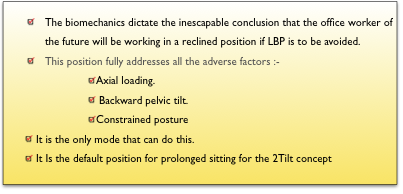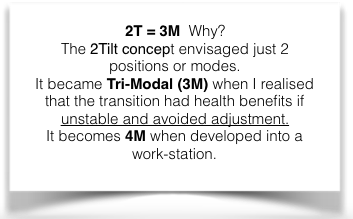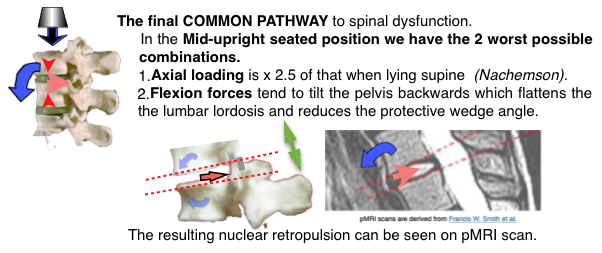Introduction to a full ergonomic solution.

For the full account to sit safely, with details, see  The 2Tilt concept, the ultimate remediation →
The 2Tilt concept, the ultimate remediation →
- Low Lumbar Backache (LBP). Some views.
- At present (2015) designers have expressed worries that an innovative and supposedly ‘paradigm change’ expressed in the 2T concept excites negative familiarity bias. This is becoming less. and the concept is especially welcome with
- The ‘millenial’ post-graduate age group. It was noticeable how students at Cambridge loved the 3M prototype and used it whenever possible.
- People who have Low Lumbar Backache. This large cohort, about 70% of the UK population, immediately see the advantages and ask “Where can I get this’. (Of course, they can’t!).
- Insurance is already begining to take an interest (personal communication). HAS
- Once people understand that it has health benefits, and possibly even more than any existing chairs, they will demand them.
- The offices of companies such as Google, Skype and Facebook, are like a playground with innovative furniture which would have looked outrageous ten years ago. This could include the 2T concept that I introduced in 1998. which is now no longer looking extraordinary.
- The ‘millenial’ post-graduate age group. It was noticeable how students at Cambridge loved the 3M prototype and used it whenever possible.
- All designers researched at a trade show expressed that their main object was based on a search for maximising ‘comfort’. Instead it should be ‘Do no harm’ based on correct medico-scientific research, as described here. Forgive me for harping on this. It has occurred to me that, in spite of much good work, this misconception and familiarity bias may have held the chair industry back from producing a much needed sitting artefact.
- The biomechanical imperatives show that to sit safely a chair can easily be achieved with the ☛ ‘2 Tilt principle’→.
- You can try embarking on the more adventurous 2T or 4M desk-less work stations.
- The 4M workstation will be particularly relevant to the coming AI, VR & MR developments.
- Please do not hesitate to get in Contact for queries, comments or more design details.
- The 2T (TriModal 3M) CONCEPT is just that – a concept. It provides a designer with a practical basis for development of an ergonomically optimised office chair which can be achieved in a number of ways and styles.
- “Desks are rather a thing of the past – Dickensian even. They evolved as tables with storage developed, alongside chairs. The whole combination seems a way of reducing/avoiding the need for floor sitting or squatting and a means to provide a convenient standing/sitting presentation of objects for working with at an ergonomically higher level. They were there to support and present paper documents and the like. Hardware, since then, was largely developed to be used with/on them and has evolved through typewriters and similar devices to today’s electronics. Once that demand for physical documents has been reduced and even eliminated by ‘paperless’ office tech.”‘ (P. Bessey).
- Manufacturers can be reassured that feasibility indicates that existing components can be used , avoiding the expense of retooling, while preserving their brand image. Prospective manufacturers can be helped to leap ahead of the field, Is your MANUFACTURER well informed and on board? If in doubt, refer to ☛MANUFACTURE of ergonomic chairs → ☛effects of sitting→
-
- The early concept depended on 2 positions, or modes, hence 2Tilt or ‘bimodal’ (2M). When I came to realise that the transition stage also carried benefits, if unstable, it became a mode
 in it’s own right. Hence the 2t became tri-modal (3M). If it can be adjusted to stop in mid-range it becomes effectively useless and is no longer a mode. Bias makes this concept difficult for most designers who have been taught to aim for infinite adjustability for comfort. A midrange position is, or is nearly, maximally ergonomically adverse and some users might mistakenly adopt it for prolonged work. A 2T chair being unstable they have a more comfortable option with the reclined or upright mode and an exercise option in mid-range. With a ‘deskless chair’ or workstation a 4th standing mode can be incorporated.
in it’s own right. Hence the 2t became tri-modal (3M). If it can be adjusted to stop in mid-range it becomes effectively useless and is no longer a mode. Bias makes this concept difficult for most designers who have been taught to aim for infinite adjustability for comfort. A midrange position is, or is nearly, maximally ergonomically adverse and some users might mistakenly adopt it for prolonged work. A 2T chair being unstable they have a more comfortable option with the reclined or upright mode and an exercise option in mid-range. With a ‘deskless chair’ or workstation a 4th standing mode can be incorporated.
Return to Chair DESIGN & Low Lumbar Backache →

